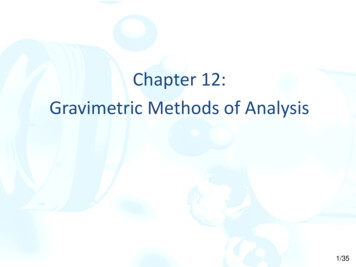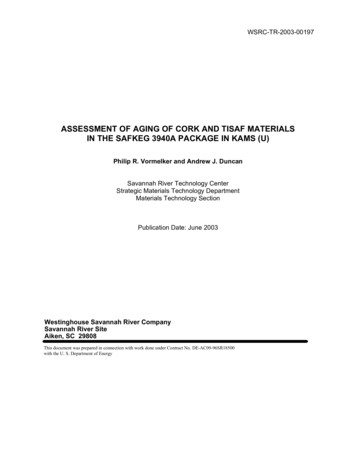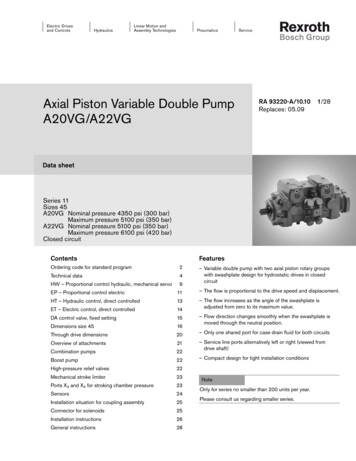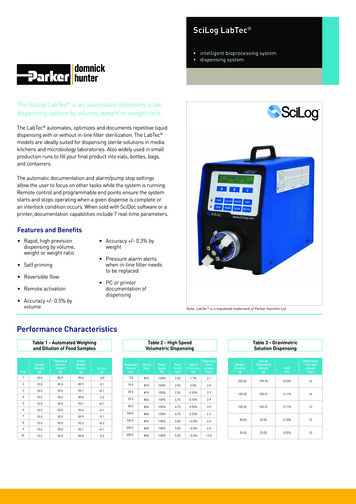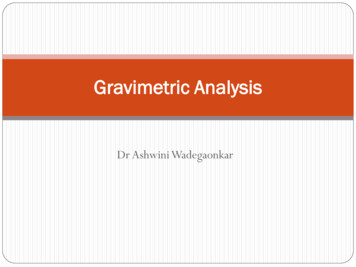
Transcription
Gravimetric AnalysisDr Ashwini Wadegaonkar
Unit 1: Gravimetric Analysis Common ion effect and solubility product principles Conditions for good precipitation Factors affecting precipitation like acid, temperature, nature of solvent Super saturation and precipitation formation Precipitation from homogeneous solution and examples Co-precipitation, post-precipitation and remedies for their minimization Washing of precipitate and ignition of precipitate Brief idea about method of filtration and drying of precipitate Introduction to electrogravimetry: principle, applications, electrolyticseparations of Cu and Ni Numerical problems only on gravimetric analysis
Introduction Gravimetric analysis is a technique through which the amount of ananalyte (the ion being analyzed) can be determined through themeasurement of mass. Gravimetric analyses depend on comparing the masses of twocompounds containing the analyte. The principle behind gravimetric analysis is that the mass of an ion in apure compound can be determined and then used to find the masspercent of the same ion in a known quantity of an impure compound. In order for the analysis to be accurate, certain conditions must be met:-The ion being analyzed must be completely precipitated.- The precipitate must be a pure compound.-The precipitate must be easily filtered.
Common ion effect and solubility product principlesCommon Ion Effect The role that the common ion effect plays in solutions is mostly visible inthe decrease of solubility of solids. Through the addition of common ions,the solubility of a compound generally decreases due to a shift inequilibrium. The common ion effect also plays a role in the regulation of buffers.Buffering solutions contain either an acid or base, accompanied by itsconjugate counterpart. Addition of more like conjugate ions willultimately shift the pH of the solution. The common ion effect must be taken into consideration whendetermining solution equilibrium upon addition of ions that are alreadypresent in the solution.
To a weak acid, when another electrolyte containing acommon ion is added the degree of dissociation of the weakelectrolyte is suppressed. Common ion effect gives valuable method to control theconcentration of the desired ion given by the weakelectrolyte.
Solubility Solubility refers to the amount of material that is able to bedissolved in a particular solvent. For example, table salt (NaCl) placed in water eventuallydissolves. However, if more table salt is continuously added, the solutionwill reach a point at which no more can be dissolved; in otherwords, the solution is saturated, and the table salt haseffectively reached its solubility limit. ility/ n/
Chemical equilibrium is the chemical state where there are no netphysical or chemical changes between the reactant and theproducts of a reaction. This is because the rate of the forward (reactant to product) andreverse (product to reactant) reactions are equal. Solubility equilibrium refers to the state of chemical equilibriumbetween a chemical compound in the solid state and a solutioncomposed of that dissolved compound. This equilibrium is established when the rates of migrationbetween the solid and aqueous phases of the molecules (or ions)are equal.
Common Ion Effect on Solubility Adding a common ion decreases solubility, as the reactionshifts toward the left to relieve the stress of the excessproduct. Adding a common ion to a dissociation reaction causes theequilibrium to shift left, toward the reactants, causingprecipitation.
https://chem.libretexts.org/Bookshelves/Physical and Theoretical Chemistry Textbook Maps/Supplemental Modules (Physical and Theoretical Chemistry)/Equilibria/Solubilty/Common Ion Effect
Solubility product In a saturated solution of a sparingly soluble electrolyte (salt), theproduct of ionic concentrations when raised to proper powers isconstant at a given temperature, is called solubility product,denoted by Ksp or S. It is when compared to ionic product, the conclusions are asfollows –1. When Ionic product Ksp, the solution is saturated, noprecipitation2. When Ionic product Ksp, the solution is unsaturated, noprecipitation3. When Ionic product Ksp, the solution is supersaturated,precipitation
Solubility product The solubility products Ksp's are equilibrium constants in hetergeneous equilibria (i.e. between two different phases).If several salts are present in a system, they all ionize in thesolution.If the salts contain a common cation or anion, these saltscontribute to the concentration of the common ion.Contributions from all salts must be included in the calculationof concentration of the common ion.Consideration of charge balance or mass balance or both leads tothe same conclusion.
When NaCl and KCl are dissolved in the same solution, the Cl ionsare common to both salts. In a system containing NaCl and KCl, the Cl ions are common ions. NaCl Na Cl KCl K Cl CaCl2 Ca2 2Cl AlCl3 Al3 3Cl AgCl Ag Cl
Precipitation To precipitate is to form an insolublecompound, either by decreasing thesolubility of a compound or by reacting twosalt solutions. The solid that forms via a precipitationreaction is called the precipitate. Precipitation reactions serve importantfunctions. They are used for purification,removing or recovering salts, for makingpigments, and to identify substances inqualitative analysis.
tml https://media.iupac.org/publications/analytical compendium/Cha09sec50.pdf
Conditions for good precipitationWhat is precipitation gravimetry? Precipitation gravimetry is an analytical technique that uses aprecipitation reaction to separate ions from a solution. The chemical that is added to cause the precipitation is calledthe precipitant or precipitating agent. The solid precipitate can be separated from the liquidcomponents using filtration, and the mass of the solid can beused along with the balanced chemical equation to calculatethe amount or concentration of ionic compounds in solution.
Ideally, an analytical precipitate for gravimetric analysisshould consist of perfect crystals large enough to be easilywashed and filtered. The perfect crystal would be free from impurities and belarge enough so that it presented a minimum surface areaonto which foreign ions could be adsorbed. The precipitate should also be "insoluble” It has been shown (Von Weimarn) that the particle size ofprecipitates is inversely proportional to the relativesupersaturation of the solution during precipitation
The following methods are used to approach these criteria Precipitation from hot solution. The solubility S of precipitatesincreases with temperature and so an increase in S decreases thesupersaturation. Precipitation from dilute solution. This keeps Q low. Slow addition ofprecipitating reagent with effective stirring. This also keeps Q low,stirring prevents local high concentrations of the precipitating agent. Precipitation at a pH near the acidic end of the pH range in whichthe precipitate is quantitative. Many precipitates are more soluble atthe lower (more acidic) pH values and so the rate of precipitation isslower. Digestion of the precipitate. Also the digestion period results in someimprovement in the internal perfection of the crystal structure[sometimes called ripening], here some internal foreign atoms may beexpelled.
CoprecipitationThis is anything unwanted which precipitates with the thing youdo want. Coprecipitation occurs to some degree in everygravimetric analysis (especially barium sulfate and thoseinvolving hydrous oxides). It can be minimized by carefulprecipitation and thorough washing. Surface adsorptionHere unwanted material is adsorbed onto the surface of theprecipitate. Digestion of a precipitate reduces the amount ofsurface area and hence the area available for surface adsorption.Washing can also remove surface material.
OcclusionThis is a type of coprecipitation in which impurities aretrapped within the growing crystal. PostprecipitationSometimes a precipitate standing in contact with the motherliquor becomes contaminated by the precipitation of animpurity on top of the desired precipitate.
Factors affecting precipitation1. Effect of Acids on the Solubility of a PrecipitateThe solubility of a sparingly soluble salt of strong acidincreases upon addition of strong acid. Addition of strongacid increases the ionic strength of the solution and hencedecreases the activity coefficients of both ions of sparinglysoluble salt.2. Effect of Temperature on the Solubility of aPrecipitateThe solubility of a precipitate increases with rise intemperature. The dissolution of a solute is mostly anendothermic process, so the solubility product constantincreases as the temperature is increased.
3. Effect of the nature of Solvent on the Solubility of aPrecipitateA solvent has a large effect upon solubility of a solute. Generally polarsolutes are more soluble in polar solvents and non polar solutes aresoluble in non polar solvents. Solubility of inorganic compounds isreduced when an organic solvents is added to water.4.Supersaturation and precipitate formationSmaller the particle size more is the solubility of a substance.A supersaturated solution the one that contains a greaterconcentrations of solute than expected equillibrium conditions at agiven temperature.Supersaturation plays important role in determining particle size ofthe precipitate.particle size of the precipitate decreases with increasing concentrationof the reactants.
Super saturation and precipitation formation A supersaturated solution is an unstable solution thatcontains more solutes than a saturated solution, with time,supersaturation is relieved by precipitation of the excesssolute. To increase the particle size of a precipitate, minimize therelative supersaturation during the precipitate formation. Relative supersaturation (Q-S)/Swhere Q is the concentration at any instant and S is theequilibrium solubility.
5.The Purity of the PrecipitateCo-precipitation – the contamination of the precipitate by substances whichare normally soluble in the mother liquor is termed as co-precipitation.Two types of co-precipitation –a. Due to surface adsorptionb. Due to formation of solid solution – OcclusionCo-precipitation can be minimized by – Taking dilute and pure solution Use double precipitation Operations like digestion or aging Use of organic solvent Slow addition of reagent Stirring Proper temperature
Post precipitation The process in which precipitation of some component(impurity) occurs on the surface after its formation is calledprecipitation. It occurs with sparingly soluble substances The longer thee time for precipitate to stand, the greater is theerror due to due to this causePost-precipitation can be minimized by – Complex formation Change in oxidation state Rapid filtration of precipitate Concentration of impurities
Distinction between Co-Precipitation and Post-Precipitation
42410/95/gravimetry-21-638.jpg?cb 1460039131
Introduction to Electrogravimetry Electrogravimetry is a method in which the element / metal to be determined is deposited electrolytically upon a suitable electrode.From the gain in the weight of electrode the amount of the metalin the sample is calculated.The method of electrogravimetry is rapid and accurate.Electrogravimetry is a method for the separation of the metalions by using the electrodes.The deposition takes place on the one electrode. The weight of thiselectrode is determined before and after deposition.This gives the amount of the metal present in the given samplesolution.
Principle of ElectrogravimetryThe main principleinvolved in this method isthe deposition of thesolid on an electrodefrom the analyte solution.
ElectrogravimeterThe material is deposited by means of potential application. Theelectrons are transported to electrode by the followingmechanisms: Diffusion Migration Convection
THEORY A metal is electrolytically deposited on the electrode by increasing the massof the electrode.M 2 2e M(S)Therefore,Eelectrolysis Ecathode Eanode The electrons deposition is governed by Ohm's and Faraday's laws ofelectrolysis which states that the amount of the electrons deposited on theelectrode is directly proportional to the amount of the current passedthrough the solution and the amount of different substances deposited isdirectly proportional to the molar masses divided by the number of electronsinvolved in the electrolysis process.
That is the current (I) is directly proportional to the electromotive force (E)and is indirectly proportional to the resistance (R).E IR From the above equation, we get the following: Eelectrolysis Ecell IR Ecell Ecathode Eanode whereTherefore, Eapplied Ecathode Eanode IR I ( Eapplied/R) 1/R(Ecathode Eanode) I (Ecell Eapplied/R) I ( Eapplied/R) K where K is the constant. A plot of the current of the applied potential in an electrolytic cell should bestraight line with a slope equal to negative reciprocal of the resistance.
Electrogravimetric plot
ravimetry.html
Electrolytic separation of Copper and Nickel Constant current electrolysis is used in the separation anddetermination of metals in alloys. Some alloys, mainly contain copper and nickel as - Monelmetal, coinage alloys, cupro-nickel alloys etc. they containimpurity like iron. The impurity is removed and the two metals are electrodeposited at different applied potentials.
Introduction Gravimetric analysis is a technique through which the amount of an analyte (the ion being analyzed) can be determined through the measurement of mass. Gravimetric analyses depend on comparing the masses of two compounds containing the analyte. The principle behind gravimetric analysis is that the mass of an ion in


